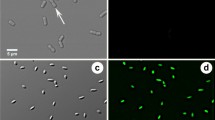Abstract
The lipopeptide antibiotic fengycin, produced by Bacillus subtilis, strongly inhibits growth of filamentous fungi. In this study, we evaluated the effects of fengycin treatment on apoptosis and necrosis in Rhizopus stolonifer by means of cell staining and epifluorescence microscopy. At fengycin concentrations less than 50 μg/ml, treated fungal cells demonstrated a dose-dependent increase in apoptosis-associated markers compared with the untreated control. These markers included chromatin condensation, reactive oxygen species accumulation, mitochondrial membrane potential depolarization, phosphatidylserine externalization, and the occurrence of DNA strand breaks. These results showed that fungal cells were impaired in a number of important functions and entered apoptosis upon treatment with low concentrations of fengycin. In contrast, high concentrations (>50 μg/ml) induced necrosis, indicating that the fungicidal action of fengycin operates via two modes: apoptosis at low concentrations and necrosis at high concentrations. Additionally, the apoptotic effect that we have shown suggests that lower concentrations of fengycin than previously thought may be effective for food preservation.
Similar content being viewed by others
References
Asaka, O. and Shoda, M. 1996. Biocontrol of Rhizoctonia solani damping-off of tomato with Bacillus subtilis RB14. Appl. Environ. Microbiol. 62, 4081–4085.
Bie, X.M., Lu, Z.X., and Lv, F.X. 2009. Identification of fengycin homologues from Bacillus subtilis with ESI-MS/CID. J. Microbiol. Methods 79, 272–278.
Chand, G.T. and Spotts, R.A. 1996. Postharvest biological control of blue mold of apple and brown rot of sweet cherry by natural saprophytic yeasts alone or in combination with low doses of fungicide. Biol. Control. 6, 253–259.
Droby, S., Chalutz, E., and Wilson, C.L. 1991. Antagonistic microorganisms as biological control agents of postharvest diseases of fruits and vegetables. Post-Harvest News Information 2, 169–173.
Eckert, J.W. and Ogawa, J.M. 1988. The chemical control of postharvest diseases: deciduous fruits, berries, vegetables, and root/ tuber crops. Annu. Rev. Phytopathol. 26, 433–469.
Fan, Q. and Tian, S.P. 2000. Postharvest biological control of Rhizopus rot of nectarine fruits by Pichia membranefaciens. Plant Dis. 84, 1212–1216.
Gueldner, R.C., Reilly, C.C., Pusey, P.L., Costello, C.E., Arrendal, R.F., Cox, R.H., Himmelsbach, D.S., Crumley, F.G., and Cutler, H.G. 1988. Isolation and identication of iturines as antifungal peptides in biological control of peach-brown rot with Bacillus subtilis. J. Agr. Food Chem. 36, 366–370.
Hagen, S., Marx, F., Ram, A.F., and Meyer, V. 2007. The antifungal protein AFP from Aspergillus giganteus inhibits chitin synthesis in sensitive fungi. Appl. Environ. Microbiol. 73, 2128–2134.
Ito, S., Ihara, T., Tamura, H., Tanaka, S., Ikeda, T., Kajihara, H., Dissanayake, C., Abddl, F.F., and Ei, M.A. 2007. α-Tomatine, the major saponin in tomato, induces programmed cell death mediated by reactive oxygen species in the fungal pathogen Fusarium oxysporum. FEBS Lett. 581, 3217–3222.
Kim, S.Y., Kim, J.Y., Kim, S.H., Bae, H.J., Yi, H., Yoon, S.H., Koo, B.S., Kwon, M., Cho, J.Y., Lee, C.E., and et al. 2007. Surfactin from Bacillus subtilis displays anti-proliferative effect via apoptosis induction, cell cycle arrest and survival signaling suppression. FEBS Lett. 581, 865–871.
Liang, S.Y. and Lu, Z.X. 2001. The isolation, screening and identification of Bacillus subtilis strain producing high activity fibrinolysin. Lett. Microbiol. China 28, 25–28.
Madeo, F., Frohlich, E., and Frohlich, K.U. 1997. A yeast mutant showing diagnostic markers of early and late apoptosis. J. Cell Biol. 139, 729–734.
Masato, E., Sakahira, H., Yokoyama, H., Okawa, K., Iwamatsu, A., and Nagata, S. 1998. A caspase activated DNase that degrades DNA during apoptosis, and its inhibitor ICAD. Nature 391, 43–50.
Narasimhan, M.L., Damsz, B., Coca, M.A., Ibeas, J.I., Yun, D.J., Pardo, J.M., Hasegawa, M.H., and Bressan, R.A. 2001. A plant defense response effector induces microbial apoptosis. Mol. Cell. 8, 921–930.
Ogawa, J.M., Zehr, E.I., Bird, G.W., Ritchie, D.F., Uriu, K., and Uyemoto, J.K. 1995. Compendium of Stone Fruit Diseases. pp. 98. APS Press.
Qi, G.F., Zhu, F.Y., Du, P., Yang, X.F., Qiu, D.W., Yu, Z.N., Chen, J.Y., and Zhao, X.Y. 2010. Lipopeptide induces apoptosis in fungal cells by a mitochondria-dependent pathway. Peptides 31, 1978–1986.
Reiter, J., Herker, E., Madeo, F., and Schmitt, M.J. 2005. Viral killer toxins induce caspase-mediated apoptosis in yeast. J. Cell Biol. 168, 353–358.
Robson, D. 2006. Programmed cell death in the Aspergilli and other filamentous fungi. Med. Mycol. 44, 109–114.
Roze, L.V. and Linz, J.E. 1998. Lovastatin triggers an apoptosis-like cell death process in the fungus Mucor racemosus. Fungal Genet. Biol. 25, 119–133.
Spotts, R.A. and Cervantes, L.A. 1986. Population, pathogenicity, and benomyl resistance of Botrytis spp., Penicillium spp., and Mucor piriformis in Packinghouses. Plant Dis. 70, 106–108.
Tang, Q.Y., Zhou, X.H., Lu, Z.X., Lv, F.X., Wang, Y.F., and Bie, X.M. 2011. Effects of fengycin from Bacillus subtilis fmbJ on respiratory chain and nutrients utilization of Rhizopus stolonifer. Food Sci. 32, 248–254.
Tao, Y., Bie, X.M., Lv, F.X., and Lu, Z.X. 2011. Antifungal activity and mechanism of fengycin in the presence and absence of commercial surfactin against Rhizopus stolonifer. J. Microbiol. 49, 146–150.
Author information
Authors and Affiliations
Corresponding author
Rights and permissions
About this article
Cite this article
Tang, Q., Bie, X., Lu, Z. et al. Effects of fengycin from Bacillus subtilis fmbJ on apoptosis and necrosis in Rhizopus stolonifer . J Microbiol. 52, 675–680 (2014). https://doi.org/10.1007/s12275-014-3605-3
Received:
Revised:
Accepted:
Published:
Issue Date:
DOI: https://doi.org/10.1007/s12275-014-3605-3




